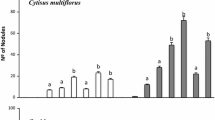Summary
By the use of a sterile culture system experiments have been carried out with peas in order to elucidate to what extent inoculation with an ineffective bacterial strain effects the ability of an effective strain to produce further nodulation. It has been established that effective strains, when applied to the plant after the formation of the first nodules by an ineffective strain, altogether fail to form nodules or the nodulation is delayed very much. Differences are noted in this respect between different bacterial strains. The results can be explained easiest by assuming that the strain first entering the roots causes an immunity in the plant against later infections. Other possibilities for explanation are also discussed. The conception that the resistance would be due to the “saturation” of roots with nodules formed by the first strain which would inhibit further nodulation is not in accordance with the results recorded.
A method has been introduced for cultivation of plants under sterile conditions by dividing the roots into two or more culture flasks. This method is of great value when the nutrient uptake of plants is elucidated. Successive inoculation with ineffective and effective strains gave varying results by this technique. The experiments seem to imply that if only a part of the root system is inoculated with an ineffective strain, immunity does not regularly occur against later infections by effective strains. This suggests that the immunity is a somewhat local phenomenon.
Similar content being viewed by others
References
A. J. Virtanen andH. Linkola, Suomen Kemistilehti B,17, 22, 1944;A. I. Virtanen, Biol. Rev. (in the press).
L. Hiltner, Deutsche Landw. Presse29, 119, 1902.
W. Israilsky, Zentralbl. f. Bakt. II,79, 354, 1929.
M. P. Löhnis, Zentralbl. f. Bakt. II,80, 342, 1930.
D. H. Dunham andI. L. Baldwin, Soil Sci.32, 235, 1931.
H. Nicol andH. G. Thornton, Proc. Roy. Soc. B,130, 32, 1941.
A. I. Virtanen, S. v. Hausen andH. Karström, Biochem. Z.258, 106, 1933;A. I. Virtanen, S. v. Hausen and T. Laine, J. Agr. Sci.27, 332, 1937;S. v. Hausen, Ann. Acad. Scient. Fenn. A,46, No. 3, 1936.
A. I. Virtanen, Nature155, 747, 1945.
H. K. Chen, J. Agr. Sci.31, 479, 1941.
Rights and permissions
About this article
Cite this article
Virtanen, A.I., Linkola, H. Competition ofRhizobium strains in nodule-formation. Antonie van Leeuwenhoek 12, 65–77 (1947). https://doi.org/10.1007/BF02272653
Received:
Issue Date:
DOI: https://doi.org/10.1007/BF02272653




